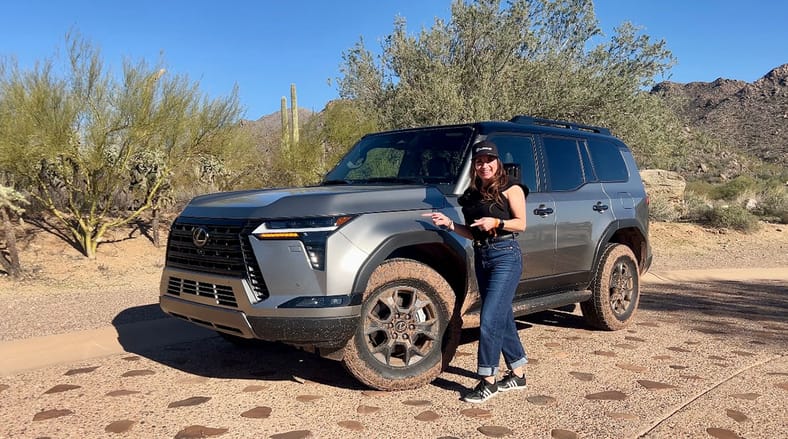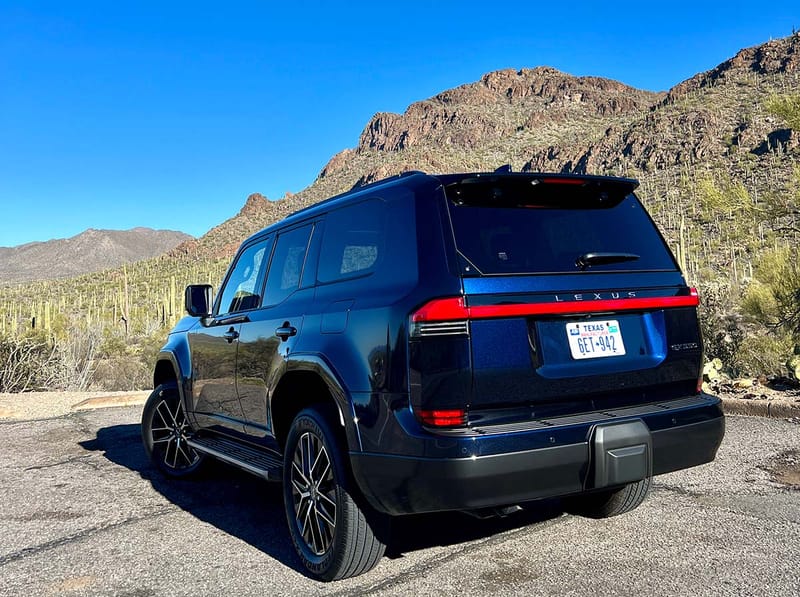Lexus LX vs GX: How These Luxury Off-Roaders are Different, and How To Choose

Lexus is no stranger to making luxury SUVs with some serious off-road chops. The Lexus LX 450 was the brand’s first SUV in 1996, based on the Toyota Land Cruiser (also lovingly called by its internal name, the J80). It was prepped and packed with trail-capable features and ready to hit the trails as soon as it was driven off the lot.
It had solid front axles, full-time four-wheel drive, optional locking diffs, optimal ground clearance, and a study body-on-frame construction. Due to its large size, more luxurious exterior, and stylish interior, it was pricey – costing $47,000 in 1996 (or $95,000 in today’s money).
The Lexus GX 470 came next in 2002, and it was built on the same platform as the Toyota 4Runner. Therefore, it offered similar off-road capabilities in a smaller package. Its smaller size made it more “affordable” than the LX, costing $45,000 (or $78,000 in today’s money).
For the 2025 model year those fundamental differences haven’t changed much in either model. The GX starts at around $65,000 MSRP and can go past $80,000, and the LX starts at $106,000 and soars to $141,000. Still, both are great for families, offer 3 rows of seats and are great in snow and sand. How are they different? Here’s what you need to know before bringing either of these off-road brutes home.
This story is 100% human-researched and written based on actual first-person knowledge, extensive experience, and expertise on the subject of cars and trucks.
Both are Toyota Land Cruiser Derived … Just Not the Same Land Cruiser

Huh? Yes, both the Lexus GX and the Lexus LX are based on the Toyota Land Cruiser, the brand’s iconic off-roader. If you live in North America, you’ve seen the Land Cruiser 250 (its internal name) a middle-weight off-roader with good but not maximum capability and seating for 5 (really, 4). This is the Land Cruiser that the Lexus GX 550 is evolved from.
In Europe, Asia and other areas, however, Toyota sells a Land Cruiser 300 (again, 300 being the internal name) which is a heavyweight in the off-roading world: Stronger, more capable, more tow capacity and slightly larger. This is the Land Cruiser that the Lexus LX 600/700h is based on.
Buyers who want the Land Cruiser 300 for all its capability will have to keep dreaming, or import it, or pony up for a Lexus LX 600 or 700h. Toyota has maintained that they won’t sell the LC 300 in North America.
Read: The 2025 Lexus LX 700h Has More Luxury and Hybrid Power, But is it Right For Your Family?
Price Sets the Lexus GX and Lexus LX Apart

They share many off-road traits and purposes, possibly the biggest class separator is price. The GX, which is designed to cost less without sacrificing the brand’s luxurious style language and brand aura, starts at $64,250 and tops out at a little more than $81,000 before adding options like head up display ($900), heated second row captains chairs ($440) and digital phone-as-key ($375).
For most buyers looking to live a more posh lifestyle without worrying too much about the car taking abuse on the trail, the Lexus GX is just right.
The LX, however, has a much higher starting price. The larger luxury off-roader starts at $106,850 for the entry-level LX 600 and tops out at over $141,000 for the hybrid Ultra Luxury model (which is essentially a limo for celebs and VIPs). LX, being a true luxury model, includes all the luxe details you’d expect—head up display, heated, massaging leather seats, premium sound, a cool box, ambient lighting—as standard equipment.
The LX is for people who want the best and live in areas with rough weather or rough roads but still want to leave a great impression while heading to work or the ski cabin.
Read: The 2024 Lexus GX 550: Polished and Posh With a Rugged Old Soul
The Second Biggest Difference? Their Engines

The GX 550, like the Land Cruiser 250 it’s based on, has the same four-cylinder twin turbo engine that generates 349 horsepower. It’s paired with a 10-speed automatic transmission—no CVTs need apply— 6,500 lbs. of tow capacity and full time 4WD, putting more control at the driver’s feet.
The LX 600 shares an engine with the Toyota Sequoia—a 3.4-liter twin-turbo V6 that produces 409 horsepower. The 700h adds a battery hybrid to the V6 that boosts HP to 457 and adds $4,000 to the price of the LX. As Toyota’s most powerful engine, it boasts 8,000 lbs. of tow capacity making it perfect as a boat, trailer, or camper hauler.
The Lexus Name Acronyms Explained

Lexus is one of several carmakers who use numbers, letters, and acronyms to name their cars. The “X” in both names means “Crossover,” the “G” means “Grand,” and “L” stands for “Luxury.” The number that follows used to stand for engine displacement size, but with changes in engines, Lexus has continued to use numbers to designate each new generation.
So, “GX 470” translated to “Grand Crossover 4.7-liter V8” and “LX 450” meant “Luxury Crossover 4.5-liter V8.”
But that was Lexus-speak before current fuel economy standards which require smaller engines that are more efficient, and customers who want more power. This generation’s names —GX 550 and LX 600 and LX 700h — don’t translate to larger “V’s” since the company is no longer using V8s in its SUVs, and doesn’t produce any engines so large they equal 6 or a 7 liter displacement. The trend is toward smaller, more powerful engines with names that continue to climb in rank.
The LX is the GX’s Slightly Bigger Brother

Make no mistake, both the GX and the LX are full-sized SUVs (though Toyota says the GX is mid-sized… don’t be fooled). Even though the Lexus GX shares the same platform as the Toyota Land Cruiser 250 (again using the internal name), it looks and feels bigger thanks to a more Lexus-esque take on the front and rear end and the addition of a 3rd row.
Even so, the GX is still smaller than the LX. The Lexus GX’s smaller frame—the LX is 3″ longer—and shorter wheelbase are designed to be more “truck-like,” with a ladder frame, locking diffs, full-time four-wheel drive, underbody protection, automatic height adjustment and more off-road-oriented features.
Both Now Have an Overtrail Edition, But There are Some Big Differences

Lexus introduced the off-road equipped Overtrail edition—which we’re pretty sure we’re going to see on every Lexus SUV at some point—a couple of years ago and included it as a trim for the 2024 GX redesign. The 2024 Lexus GX Overtrail, priced from $72,930, adds all-terrain wheels, underbody skid plates, running boards, exclusive exterior colors and rear and center locking differentials.
Then, when Lexus redesigned the LX, an Overtrail edition was added but only in the more powerful and more expensive 700h model, priced around $113,000. The biggest difference between the GX and LX Overtrail editions is, of course, price. But there are 3 other major considerations: the LX has a 3rd row, it has a significantly smaller cargo area—31 cubic feet (thanks to the hybrid battery) vs. 46 cubic feet in the GX Overtrail, and it has a 3rd locking differential. Lexus added a front locking diff for maximum traction, noting that a triple locking diff adds to resale value and is very popular among buyers.
Both GX and LX Have Three Rows … But One is Better For Families

This is a major deciding factor, especially for those who plan to have passengers, or kids, in the rear seats: The GX, which has the same transmission tunnel issue as the Toyota Land Cruiser, has a 3rd row and the option of center row captains chairs, making both the center row seats more comfortable and the 3rd row both more comfortable and easier to reach.
A bench is only advisable if the 3rd row will rarely be used; center row seats fold and flip for 3rd row access; they are not on a rail and don’t slide backward or forward for either 3rd row access or comfort. In our opinion, families who need regular 3rd row access will find the GX preferable to the LX.
LX Forgoes Captains Chairs for a Bench Seat

This same configuration—center row fold and flip seats for 3rd row access—is seen in the Lexus LX, and there is not a captains chair option. The LX only comes with a center row bench seat (except in the Ultra Luxury model, but it’s essentially a limo and does not have a 3rd row).
With center row fold and flip seats, 3rd row legroom isn’t adjustable; center row seats can’t be moved forward at all.
We sat in the 3rd row of the LX, which is nearly the same size as the 3rd row in the GX, and found it OK for smaller passengers. For myself and my drive partner, two 5’8″ women, we fit in the 3rd row adequately but wouldn’t want to ride that way for long.
READ MORE: Toyota Land Cruiser Vs. Lexus GX: Which Bold and Badass Iconic SUV Should You Buy?
How’s the Cargo Space?

Both the GX and LX suffer the same cringe-worthy lack of cargo space behind the third row when it’s in use, and the LX 700h has even less space thanks to a hybrid battery that sits under the rear seats.
Both the LX and GX, with the 3rd row up, have a cargo space that is about 10 inches deep, enough for some backpacks or tote bags but not much else.
With the 3rd row folded, the LX 700h, thanks to the battery, has about 31 cubic feet of cargo space. That’s significantly smaller than the the LX 600’s 44 cubic feet and the GX’s 46 cubic feet.
Which is Better for Off-Roading?

Lexus described the GX as a mid-weight off-roader, which the LX is more of a heavyweight, though both offer quite a lot of off-road capability. So in general, the LX is better thanks to the larger engine and better capability. But in reality, both are quite capable.
For those for whom the goal is primarily off-roading, the Overtrail edition options are a bit more clear cut: if you can live with seating for 4, the GX, at about $40,000 less than the LX, seems like a deal. If seating for 7 or the additional 108 HP is what matters, the LX 700h, at $115K, is the way to go.
So, Which is Better?

Really, it boils down to two things: price (and features) and seating.
Priced at nearly half the entry-level price of the LX, the GX is a very nice and capable SUV with lots of comforts, though it has a smaller engine. Upgrade to the Plus version of each trim and add more features; the price ladders up pretty quickly. Still, for a mid-$80K price at the top of the line, you’ll get a nearly as nicely equipped Lexus as the entry-level LX 600 ($106K), though it has 60 more horsepower.
What the GX offers that the LX doesn’t, though, is captains chairs. If regular use of the 3rd row is a must, the GX may be the better option even with a smaller engine (it’s still quite capable). Both GX and LX have two full LATCH sets in the center row that easily accessible for installing car seats and both can accommodate rear facing child car seats.
Either way, both are incredibly beautiful, capable, and versatile vehicles. Trust us when we say: we’d be happy to have either one in our driveways, and we think you will, too.
More About:Car Culture
